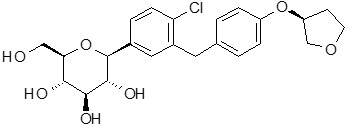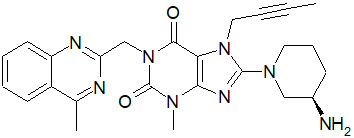Empagliflozin
Generic name: empagliflozin
Brand name: Jardiance
Dosage form: oral tablet (10 mg; 25 mg)
Drug class: SGLT-2 inhibitors
Medically reviewed by A Ras MD.
What is Empagliflozin?
Empagliflozin is used to lower blood sugar in patients with high blood sugar (diabetes). It is used to lower the chance of death from heart disease in certain people.
Description
GLYXAMBI tablets for oral use contain: empagliflozin and linagliptin.
Empagliflozin
Empagliflozin is an inhibitor of the sodium-glucose co-transporter 2 (SGLT2).
The chemical name of empagliflozin is D-Glucitol,1,5-anhydro-1-C-[4-chloro-3-[[4-[[(3S)-tetrahydro-3-furanyl]oxy]phenyl]methyl]phenyl]-, (1S).
The molecular formula is C23H27ClO7 and the molecular weight is 450.91. The structural formula is:

Empagliflozin is a white to yellowish, non-hygroscopic powder. It is very slightly soluble in water, sparingly soluble in methanol, slightly soluble in ethanol and acetonitrile, soluble in 50% acetonitrile/water, and practically insoluble in toluene.
Linagliptin
Linagliptin is an inhibitor of the dipeptidyl peptidase-4 (DPP-4) enzyme.
The chemical name of linagliptin is 1H-Purine-2,6-dione, 8-[(3R)-3-amino-1-piperidinyl]-7-(2-butyn-1-yl)-3,7-dihydro-3-methyl-1-[(4-methyl-2-quinazolinyl)methyl]-
The molecular formula is C25H28N8O2 and the molecular weight is 472.54. The structural formula is:

Linagliptin is a white to yellowish, not or only slightly hygroscopic solid substance. It is very slightly soluble in water. Linagliptin is soluble in methanol, sparingly soluble in ethanol, very slightly soluble in isopropanol, and very slightly soluble in acetone.
GLYXAMBI
GLYXAMBI tablets are available in two dosage strengths containing 10 mg or 25 mg empagliflozin in combination with 5 mg linagliptin. The inactive ingredients of GLYXAMBI are the following: Tablet Core: mannitol, pregelatinized starch, corn starch, copovidone, crospovidone, talc and magnesium stearate. Coating: hypromellose, mannitol, talc, titanium dioxide, polyethylene glycol and ferric oxide, yellow (10 mg/5 mg) or ferric oxide, red (25 mg/5 mg).
Mechanism of Action
GLYXAMBI
GLYXAMBI contains: empagliflozin, a sodium-glucose co-transporter 2 (SGLT2) inhibitor, and linagliptin, a dipeptidyl peptidase-4 (DPP-4) inhibitor.
Empagliflozin
Sodium-glucose co-transporter 2 (SGLT2) is the predominant transporter responsible for reabsorption of glucose from the glomerular filtrate back into the circulation. Empagliflozin is an inhibitor of SGLT2. By inhibiting SGLT2, empagliflozin reduces renal reabsorption of filtered glucose and lowers the renal threshold for glucose, and thereby increases urinary glucose excretion.
Linagliptin
Linagliptin is an inhibitor of DPP-4, an enzyme that degrades the incretin hormones glucagon-like peptide-1 (GLP-1) and glucose-dependent insulinotropic polypeptide (GIP). Thus, linagliptin increases the concentrations of active incretin hormones, stimulating the release of insulin in a glucose-dependent manner and decreasing the levels of glucagon in the circulation. Both incretin hormones are involved in the physiological regulation of glucose homeostasis. Incretin hormones are secreted at a low basal level throughout the day and levels rise immediately after meal intake. GLP-1 and GIP increase insulin biosynthesis and secretion from pancreatic beta cells in the presence of normal and elevated blood glucose levels. Furthermore, GLP-1 also reduces glucagon secretion from pancreatic alpha cells, resulting in a reduction in hepatic glucose output.
Before taking Empagliflozin, tell your doctor:
- If you are allergic to empagliflozin; any part of this medicine; or any other drugs, foods, or substances. Tell your doctor about the allergy and what signs you had.
- If you have any of these health problems: Acidic blood problem or type 1 diabetes.
- If you have kidney disease.
- If you are dehydrated, talk with your doctor.
- If you are not able to eat or drink like normal, including before certain procedures or surgery.
- If you are pregnant or may be pregnant. Do not take empagliflozin if you are in the second or third trimester of pregnancy.
- If you are breast-feeding. Do not breast-feed while you take empagliflozin.
This is not a list of all drugs or health problems that interact with empagliflozin.
Tell your doctor and pharmacist about all of your drugs (prescription or OTC, natural products, vitamins) and health problems. You must check to make sure that it is safe for you to take empagliflozin with all of your drugs and health problems. Do not start, stop, or change the dose of any drug without checking with your doctor.
What are some things I need to know or do while I take Empagliflozin?
- Tell all of your health care providers that you take empagliflozin. This includes your doctors, nurses, pharmacists, and dentists.
- Do not drive if your blood sugar has been low. There is a greater chance of you having a crash.
- To lower the chance of feeling dizzy or passing out, rise slowly if you have been sitting or lying down. Be careful going up and down stairs.
- Be careful in hot weather or while being active. Drink lots of fluids to stop fluid loss.
- If you cannot drink liquids by mouth or if you have upset stomach, throwing up, or diarrhea that does not go away; you need to avoid getting dehydrated. Contact your doctor to find out what to do. Dehydration may lead to new or worse kidney problems.
- High cholesterol has happened with empagliflozin. If you have questions, talk with the doctor.
- Have blood work checked as you have been told by the doctor. Talk with the doctor.
- This medicine may affect certain lab tests. Tell all of your health care providers and lab workers that you take empagliflozin.
- It may be harder to control blood sugar during times of stress such as fever, infection, injury, or surgery. A change in physical activity, exercise, or diet may also affect blood sugar.
- Check your blood sugar as you have been told by your doctor.
- Talk with your doctor about which glucose tests are best to use.
- Too much acid in the blood or urine (ketoacidosis) and severe urinary tract infections (UTIs) have happened. Ketoacidosis can be deadly. Both of these may need to be treated in a hospital.
- Kidney problems have happened. Sometimes, these may need to be treated in the hospital or with dialysis.
- Follow the diet and workout plan that your doctor told you about.
- If you are on a low-salt or salt-free diet, talk with your doctor.
- Talk with your doctor before you drink alcohol.
- A rare but very bad infection has happened with drugs like this one. This infection may be deadly. Get medical help right away if your genitals or the area between your genitals and rectum becomes tender, red, or swollen, and you have a fever or do not feel well.
- If you are 65 or older, use empagliflozin with care. You could have more side effects.
- This medicine may cause harm to the unborn baby if you take it while you are pregnant. If you are pregnant or you get pregnant while taking empagliflozin, call your doctor right away.
How is Empagliflozin best taken?
Use empagliflozin as ordered by your doctor. Read all information given to you. Follow all instructions closely.
- Take with or without food.
- Take in the morning.
- Drink lots of noncaffeine liquids unless told to drink less liquid by your doctor.
- Keep taking empagliflozin as you have been told by your doctor or other health care provider, even if you feel well.
What do I do if I miss a dose?
- Take a missed dose as soon as you think about it.
- If it is close to the time for your next dose, skip the missed dose and go back to your normal time.
- Do not take 2 doses at the same time or extra doses.
- If you are not sure what to do if you miss a dose, call your doctor.
What are the side effects of Empagliflozin that I need to call my doctor about immediately?
WARNING/CAUTION: Even though it may be rare, some people may have very bad and sometimes deadly side effects when taking a drug. Tell your doctor or get medical help right away if you have any of the following signs or symptoms that may be related to a very bad side effect:
- Signs of an allergic reaction, like rash; hives; itching; red, swollen, blistered, or peeling skin with or without fever; wheezing; tightness in the chest or throat; trouble breathing, swallowing, or talking; unusual hoarseness; or swelling of the mouth, face, lips, tongue, or throat.
- Signs of fluid and electrolyte problems like mood changes, confusion, muscle pain or weakness, a heartbeat that does not feel normal, very bad dizziness or passing out, fast heartbeat, more thirst, seizures, feeling very tired or weak, not hungry, unable to pass urine or change in the amount of urine produced, dry mouth, dry eyes, or very bad upset stomach or throwing up.
- Signs of kidney problems like unable to pass urine, change in how much urine is passed, blood in the urine, or a big weight gain.
- Signs of too much acid in the blood (acidosis) like confusion; fast breathing; fast heartbeat; a heartbeat that does not feel normal; very bad stomach pain, upset stomach, or throwing up; feeling very sleepy; shortness of breath; or feeling very tired or weak.
- Signs of a urinary tract infection (UTI) like blood in the urine, burning or pain when passing urine, feeling the need to pass urine often or right away, fever, lower stomach pain, or pelvic pain.
- For females, vaginal yeast infection. Report itching or discharge.
- For men, yeast infection of the penis. Report pain, swelling, rash, or discharge.
- Low blood sugar can happen. The chance may be raised when empagliflozin is used with other drugs for diabetes. Signs may be dizziness, headache, feeling sleepy or weak, shaking, fast heartbeat, confusion, hunger, or sweating. Call your doctor right away if you have any of these signs. Follow what you have been told to do for low blood sugar. This may include taking glucose tablets, liquid glucose, or some fruit juices.
What are some other side effects of Empagliflozin?
All drugs may cause side effects. However, many people have no side effects or only have minor side effects. Call your doctor or get medical help if you have any side effects that bother you or do not go away.
These are not all of the side effects that may occur. If you have questions about side effects, call your doctor. Call your doctor for medical advice about side effects.
You may report side effects to the FDA at 1-800-332-1088. You may also report side effects at https://www.fda.gov/medwatch.
If overdose is suspected:
If you think there has been an overdose, call your poison control center or get medical care right away. Be ready to tell or show what was taken, how much, and when it happened.
How do I store and/or throw out Empagliflozin?
- Store at room temperature.
- Store in a dry place. Do not store in a bathroom.
- Keep all drugs in a safe place. Keep all drugs out of the reach of children and pets.
- Throw away unused or expired drugs. Do not flush down a toilet or pour down a drain unless you are told to do so. Check with your pharmacist if you have questions about the best way to throw out drugs. There may be drug take-back programs in your area.
SRC: NLM .
